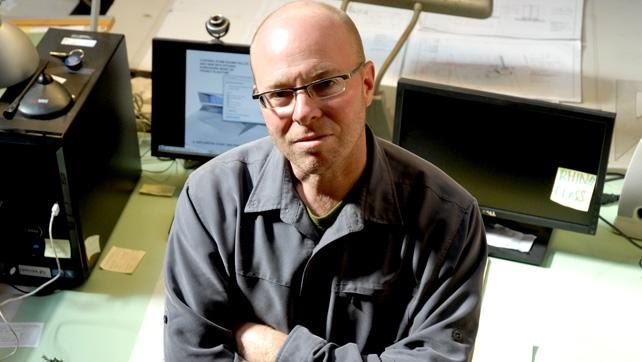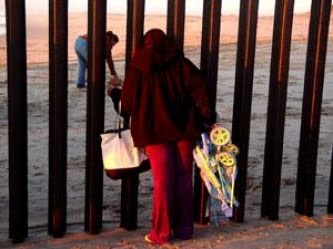December 16, 2010 Originally published in San Diego City Beat
The second in our series on border art looks at the architect behind the proposed design of Friendship Park
by Kinsee Morlan

When James Brown was in his 20s, he walked, on a whim, from his house in San Diego to Tecate, Mexico. Including a quick stop in La Mesa to bowl, the trek took 48 hours.
Brown’s drawn to Mexico, but that isn’t really why he got involved in the redesign of Friendship Park, the plaza inside Border Field State Park in San Ysidro, where the United States ends and Mexico begins. His interest in the highly politicized plot of land began in 2008 in Cambridge, Mass., when he was awarded the Loeb Fellowship and spent a year of independent study at Harvard. Those 12 months were the first time in a long time that Brown, who runs Public Architecture with his partner James Gates, had time to take a step back.
“The program really challenged me to think,” the soft-spoken Brown says. “I didn’t feel like I’d done much to help my city, as a leader, especially. I’ve done some great buildings, some great art and furniture…. But I wanted to try.”
As recently as 2008, Friendship Park was a place where people in Mexico could meet with family in the U.S. It was an opportunity for those separated by immigration status to talk in person and even touch. But photos of fathers linking hands with their children through the fence, or couples picnicking on the beach separated only by a few rusty poles are the only remnants of the park’s former state.

“This is degrading somehow—it’s dehumanizing,” Peter Zamora says, standing on the Tijuana side of Friendship Park a few weeks ago. For years, Zamora lived in San Diego and used the park to meet his wife and kids. He was recently deported, but he and his family frequently come back to visit the place where they spent so much invaluable time. He’s watched the park change dramatically in the last few years. “You know the dog pound?” Zamora asked. “That’s what it feels like now. I’m about to start barking.”
In late 2008, the Department of Homeland Security announced plans to build a double border fence and increase security. In early 2009, the department surprised everyone when it said that construction plans included the full closure of Friendship Park. By February of 2009, Border Patrol agents started denying access to the plaza. Border activists protested and worked hard that year to get access to the park. By November of 2009, they regained limited entry. The Army Corps of Engineers added a gate to the new fence, which can be opened only during certain hours on certain days. Visitors are allowed to walk through what’s been described as a “cattle run” to get to yet another short fence, which keeps people roughly five feet away from the original border fence. Visitors are only allowed to stay 30 minutes and can no longer touch friends and family on the other side.
“The mistruth that several Border Patrol officials have stated regarding the opening is, ‘Well, everybody got 99 percent of what they wanted,’ which is completely and utterly false,” says John Fanestil, executive director of Foundation for Change and a member of Friends of Friendship Park, a coalition formed in 2008 to push for more access to the park. Brown’s proposal, Fanestil adds, “doesn’t even get us 99 percent of what we want, but it gets us a long way. He’s done a masterful job of accommodating some of the concerns [of the Border Patrol], but it would be equally false for me to say his design meets all of their concerns.”
That’s Brown’s biggest challenge—designing a park that includes both the dignity and freedom desired by border activists and the control demanded by the U.S. government.
Back at Harvard, Brown used his time to conceptualize a binational park that would include huge swaths of land in both the United States and Mexico. “I didn’t know anything about the Friends of Friendship Park at this time,” he says. “So, I was just working on my own thing…. I was very much in a vacuum.”
Brown walks through his office in University Heights, where he’s laid out drawings and models he built during his fellowship.
“My idea would be to have the trolley snake out there,” he says, pointing at a drawing hanging on the wall. “And there would be a pedestrian and bicycle crossing—no cars.”
The Friends of Friendship Park came across Brown’s work on the binational park at Mix: Nine San Diego Architects and Designers, an exhibition on view at the Museum of Contemporary Art San Diego last year.
Brown met with the group and volunteered to come up with a more realistic design to allow greater access to the park. The resulting design isn’t as idealistic as his original plans for a binational park, but it’s a start. The proposal includes a 60-foot rolling gate that can be opened all the way or closed depending on the Border Patrol’s comfort level. Many of the gates currently inside the park would be replaced with knee-high looping chains, and paths would lead down to the beach and to private meeting areas where families could sit and talk. A grove of native trees would stretch across the border.
“We’re proposing three main points,” Brown explains. “We want access to the monument. We want access to the binational garden and we want to get access to the beach.
“This is the feeling it would give,” Brown continues, unrolling a printout of the design. “Instead of that closed-off feeling, it would have some semblance to a regular park.”
A few months ago, without any warning, a high-tech security tower was built on the U.S. side, just outside Friendship Park. The tower adds to the overall ominous and militarized atmosphere. The gesture is symbolic, Brown says, of the attitudes of the Department of Homeland Security.
“It seems impenetrable to me at times,” he says. “We’ve been meeting with the Border Patrol forever; you’d think they would have told us about the tower.”
Border Patrol spokesperson Steven Pitts says Brown’s design is currently with the Army Corps of Engineers. “It’s being looked at seriously,” Pitts says.
But Brown and the Friends of Friendship Park know it’s going to take a big push to move the plans forward.
“We’ve been waiting for the right time,” Fanestil says, “but soon we will mobilize again in support of the plan that Jim Brown is developing, and we’ll continue to advocate for greater and greater access.”
Brown has faith. The group of activists behind his design has already seen success in gaining limited access to the park, and he thinks that with their support, his work will see the light of day. The moment they get the green light from the U.S. government, Brown says, the next hurdle—finding the money— won’t be a problem.
“The funding will come,” Brown says. “If we could possibly get to the point where the Border Patrol would say, ‘Well, yes, we don’t have a problem with this, but where are we going to get the money?’ that would be a huge victory. We would find a way to do it if we could get to that critical stage.”
Photo Credits: Kinsee Morlan
Got comments or questions? Email kinseem@sdcitybeat.com

